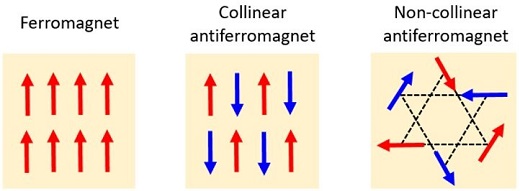by Tohoku University

Fig. 1. Spin structures of a ferromagnet, a collinear antiferromagnet, and a non-collinear antiferromagnet. Credit: Tohoku University
Electronics play a pivotal role in today's information society. Yet only the electron charge in electronic devices is at play, making energy dissipation an increasingly pressing issue that thwarts further development. Spintronics, an interdisciplinary field in which an electron's charge and spin degrees of freedom are utilized simultaneously, enables electric control of magnetism and vice versa, paving a path towards energy-efficient and high-speed information technologies beyond the current semiconductor-based electronics.
While ferromagnets have dominated spintronics research and applications, antiferromagnets with non-trivial spin structures (Fig. 1) have attracted interest. Antiferromagnetic spintronics hold the potential to build highly integrated and ultrafast spintronic hardware.
A research team has recently highlighted a series of critical achievements in antiferromagnetic spintronics (including their own contributions), revealing an emerging frontier distinguished by the coherent spin dynamics of antiferromagnets. Details were published as a review article in Nature Materials on March 20, 2023.
The team comprised Jiahao Han, Shunsuke Fukami, and Hideo Ohno from Tohoku University; Ran Cheng from the University of California, Riverside; and Luqiao Liu from the Massachusetts Institute of Technology.
Within antiferromagnetic spintronics, scientists have exerted much effort on the switching and readout of static magnetic order. But coherent spin dynamics, the key to exploring the wave features of spins and integrating spintronics with quantum and neuromorphic technologies, has only received attention very recently. "The coherent spin dynamics of antiferromagnets exhibits a lot more intriguing features than that of ferromagnets [illustrated in Fig. 2]," says Jiahao Han, a JSPS Research Fellow working at the Research Institute of Electrical Communication (RIEC), Tohoku University. "By harnessing this unique property, the team has been pursuing breakthroughs that eventually form a new chapter named coherent antiferromagnetic spintronics."

Fig. 2. Coherent spin dynamics (magnon modes) of a ferromagnet (right-handed mode), an easy-axis collinear antiferromagnet (left-handed and right-handed modes), and an easy-plane collinear antiferromagnet (in-plane and out-of-plane modes). Credit: Tohoku University
The team holistically analyzed the crucial findings in coherent antiferromagnetic spintronics, including spin generation and transport, electrically driven spin rotation, and related ultrafast spintronic effects. Remarkably, several important pieces of primary research in this field came from the members of this team. Cheng et al. predicted the generation of spin current from coherent spin dynamics and the picosecond magnetic switching in antiferromagnets. Liu, Han et al. demonstrated long-distance transport of phase-correlated antiferromagnetic spin excitations. Fukami, Ohno et al. reported current-induced chiral-spin rotation in non-collinear antiferromagnets. These discoveries lay the physical foundation for practical applications to come, such as ultrafast nonvolatile memory, ultrafast wave-based computing, and terahertz nano-oscillators.
In their article, the team suggested several research directions that may facilitate ongoing studies and fuel the future of coherent antiferromagnetic spintronics. "While the spintronics community has devoted tremendous efforts to ferromagnets, there still remains a lot to do with antiferromagnets," says Shunsuke Fukami, professor at RIEC. "For example, we need to synthesize antiferromagnets with more controllable domain patterns to enhance the spin coherence. The magnetic switching process should be visualized in a time-resolved manner to guide the optimization of the operation speed. And the exploration of novel quantum effects is highly desirable for developing dissipationless communication and computing devices."
The team is optimistic that through cooperative efforts from physicists, material scientists and electrical engineers, the rapidly growing field of coherent antiferromagnetic spintronics is expected to accelerate fundamental and practical research towards efficient, ultrafast, and integrated hardware for the next-generation information technologies.

